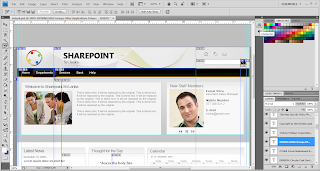What is SharePoint 2010 Branding?
The companies have chosen a marketing identity that enables the public to quickly and easily recognize them. This is branding. When referring to websites, branding usually involves the colors, fonts, logos, and supporting graphics that make up the general look and feel of the website.
The objectives that a excellent brand will achieve include:
1. Delivers the message clearly
2. Confirms your credibility
3. Connects your target prospects emotionally
4. Motivates the buyer
5. Concretes User Loyalty
Branding for SharePoint
Branding for SharePoint is similar to branding for any other sites, except that branding for SharePoint includes the master pages, page layouts, Cascading Style Sheets (CSS), jquery, Web Parts and eXtensible Stylesheet Language Transformations (XSLT).
Basically sharepoint 2010 will look like this:

Definition of Branding
The most common reason to brand a SharePoint site is to make it unique. Out of the box, SharePoint 2010 is not visually help you started. In fact, its look and feel is intentionally bland, as it is assumed that most companies are going to customize it. Indeed, making it “not look like SharePoint” is a basic request.
Themes
themes can be changes that are applied to the existing look and feel through the use of CSS. In SharePoint 2007, themes played a similar function, but behind the scenes, they worked completely differently than they do in SharePoint 2010.
In SharePoint 2010, themes are created with the Microsoft Office client software (2007 and above),using PowerPoint to create .THMX files that describe the 12 theme colors and two fonts available in the new SharePoint themes. Once created with Office, they can be loaded into SharePoint 2010 and applied to any site by site owners.
Along with the capability to create themes in the Office client, the Server version of SharePoint 2010 enables site owners to modify the themes — i.e., the colors and fonts — directly in the SharePoint Web user interface the changes can be viewed immediately.
further details about THEME you can go to below link:
http://erikswenson.blogspot.com/2010/01/sharepoint-2010-themes.html
Master Pages
I have discussed about master pages in same blog in title of "SharePoint 2010: Master Pages" on july 29, 2010 before brifly and this is my favorite part in sharepoint 2010. this time will comes with a few out-of-the-box master pages that can be used for website branding right away. The following list describes some of the more important out-of-the-box master pages:
v4.master — This is the default master page that is used for many of the site templates used by SharePoint 2010, and is the page shown earlier.
nightandday.master — This master page is accessible only in a SharePoint Server 2010 site that has the Publishing Feature enabled. Unlike v4.master (which is geared toward intranet sites), this master page is styled in a more simplistic way and is more appropriate for an Internet site. Because the underlying code for the master page is well organized, this can be a good place to look when you are first learning about master pages.
minimal.master — This master page is used only on pages that have their own navigation or need extra space (such as dedicated application pages or the search center). Unlike the concept of minimal master pages in SharePoint 2007, this master page is not intended to be the starting point for branding, as it lacks several common SharePoint controls.
Cascading Style Sheets
CSS is pervasive in SharePoint branding. Almost every aspect of SharePoint is styled by CSS. All the SharePoint controls that are loaded by a master page are styled by CSS, as well as many Web Parts — even SharePoint themes apply to specially commented CSS fi les in SharePoint 2010. Because of the importance of CSS in SharePoint, a sound understanding of it is crucial to becoming skilled at branding in SharePoint.
further details about CSS you can go to below link:
http://www.w3schools.com/css
Content Pages
there are three main types of content pages in SharePoint Server 2010:
1. Publishing pages (SharePoint Server 2010 only)
2. Web Part pages
3. Wiki pages
Each type of page has different options and a different intended use, so your functional requirements will dictate which page is right for each scenario.



this is a great blog... it helped me lot and thanks for you effort
ReplyDelete